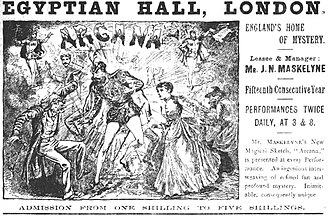Egyptian Hall

The Egyptian Hall in Piccadilly, London, was an exhibition hall built in the ancient Egyptian style in 1812, to the designs of Peter Frederick Robinson. The Hall was a considerable success, with exhibitions of artwork and of Napoleonic era relics. The hall was later used for popular entertainments and lectures, and developed an association with magic and spiritualism, becoming known as "England's Home of Mystery".
In 1905, the building was demolished to make way for flats and offices.
History

The Egyptian Hall was commissioned by

The Hall was a considerable success, with an exhibition of
The bookseller
In the "Dudley Gallery" at the Egyptian Hall, the valuable collection of pictures belonging to the
The hall was used principally for popular entertainments and lectures. Here Albert Smith related his ascent of Mont Blanc, illustrated by some cleverly dioramic views of the Alpine peaks.[10]

By the end of the nineteenth century, the Hall was also associated with magic and spiritualism, as a number of performers and lecturers had hired it for shows. In 1873 William Morton took on the management of the Hall and modified it for his protegees, Maskelyne and Cooke, whose run there lasted a remarkable 31 years.[11] The Hall became known as England's Home of Mystery. Many illusions were staged including the exposition of fraudulent spiritualistic manifestations then being practised by charlatans. The final performance was on 5 January 1905.[12]
In 1905 the building was demolished
Hotten documents the name in 1859 used as rhyming slang for a ball. Franklyn comments in 1960 "The term was demolished with the building."[15]
See also
- Egyptian Revival architecture in the British Isles
- Egyptian revival decorative arts
- List of demolished buildings and structures in London
References
- ^ Adrienne L. Kaeppler, "Cook Voyage Provenance of the 'Artificial Curiosities' of Bullock's Museum" Man, New Series, 9.1 (March 1974), pp. 68–92.
- ^ W.H. Mullens, "Some museums of old London: II William Bullock's London Museum", Museum Journal 17 (1917–18) pp 51–56, 132–37, 180–87; Tom Iredale, "Bullock's Museum", Australian Zoology 2 (1948) pp 233–37.
- ^ Howard Colvin, A Biographical Dictionary of British Architects 1600–1840, third ed. (Yale University Press) 1995, s.v. "Robinson, Peter Frederick"; Survey of London vol. xxix.
- ^ "Bullock's Egyptian Hall". Archived from the original on 14 May 2011. Retrieved 20 July 2006.
- ^ William Bullock, A Catalogue of the Liverpool Museum was in its third edition in 1801 (copy in the Liverpool Public Museum, noted by Kaeppler 1974).
- ISBN 1-85437-513-X
- ^ Kaeppler 1974 traces the ethnographic collection from Cook's voyage and clears up many misconceptions about the pieces.
- ISBN 1-85437-513-X
- ^ Noon & Bann, pp. 91–2 (with a print illustrated), prints Archived 26 May 2011 at the Wayback Machine
- ^ "The Egyptian Hall, Piccadilly, London". www.arthurlloyd.co.uk. Retrieved 16 June 2016.
- ^ Hull Daily Mail, 11 February 1937 p. 6 Old-New Maskelyne Trick
- ^ ‘All the Year Round’, The Era, 2 January 1924 p. 6
- ^ https://www.ltmuseum.co.uk/collections/collections-online/photographs/item/1999-1908
- ^ http://www.arthurlloyd.co.uk/EgyptianHallPiccadilly.htm
- ^ Julian Franklyn (1960). A Dictionary of Rhyming Slang. London: Routledge and Keegan Paul. p. 61.
